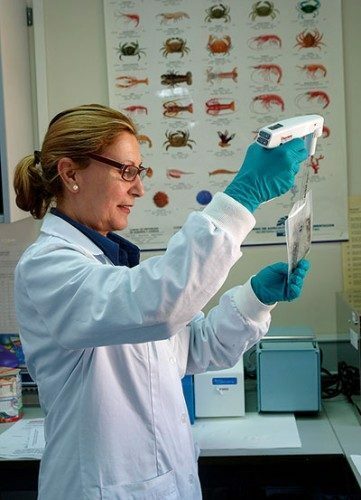Levels of Organization of Matter
Chemistry / / July 04, 2021
The levels of organization of matter They are the divisions of the components of all matter for study, from its most basic particles to the most complex organisms.
The first four levels are common to organic and inorganic matter. From the next level, the levels of organization refer to the complexity of the organisms living, so this study of the organization of matter is common to both chemistry and biology.
Levels of organization of organic and inorganic matter:

First level of organization:
Elemental particles.- In the first level are the elementary particles, which are quarks and leptons.
These elementary particles are the most basic components of matter so far known. Quarks are the smallest particles that make up the structures of the atomic nucleus. Among the structures that are formed by quarks, protons and neutrons stand out, the elements that make up the nucleus.
Leptons are other elementary particles that make up electrons.
Second level of organization:
Subatomic particles.- At this level we find the particles found in the nucleus and in the atomic orbits. The quarks are not isolated in nature, but grouped in hadrons, groups of 2 (mesons) or 3 quarks (baryons) As main components, in the nucleus we find protons (with positive charges) and neutrons (with charges neutral).
For their part, leptons unite in pairs to form the subatomic particles that surround the nucleus, the main one being electrons.
Third level of organization:
Atoms.- The atom is the third level. An atom is made up of a nucleus, which contains protons and neutrons, which are the heaviest component of the atom, and the electrons that revolve around the nucleus. At this level, the atom of any element already has the characteristics of that element: atomic weight, boiling and condensation points, combination capacities, etc.
Fourth level of organization:
Molecules.- At the molecular level, we find the atoms combining with each other. Molecules are the combination of two or more atoms, of the same element or different elements, joined by strong ionic bonds, behaving as a unit.
Molecules are divided into inorganic and organic. Inorganic or polyatomic molecules are formed by various atoms, and depending on the type of bonds and their components, they are divided into oxides, hydroxides, acids, hydrides and salts.
Organic molecules, also known as biomolecules, are molecules whose structure is made up of a skeleton of carbon atoms.
Up to this fourth level, the levels of organization of matter are common to organic and inorganic conglomerates.
The rest of the inorganic matter and its combinations are always modified forming new structures that remain in the molecular level, only changing its state of aggregation, but without modifying its state of conglomerates of molecules.
The following levels of organization correspond to the levels of biological organization:
Biological levels of organization:
First level of biological organization:
Organelles.- At this level, we find groupings of molecules that come together to perform a specific function. Among the organelles, we have those that correspond to plants, such as chloroplasts, mitochondria, endoplasmic reticulum, ribosomes, vacuoles, flagella or membranes.
Second level of biological organization:
Cells.- At this level, it is considered the organization of the organelles, in which each one of them performs its function to enable the relational and survival functions of a set that functions as a unit: the cell.
The cell is the smallest unit that can be considered as something “alive”. The cell can form an organism by itself (unicellular organisms) or be part of a functional group to form a more complex organism (multicellular organisms).
Third level of biological organization:
Tissue.- Tissues are groups of cells specialized in carrying out a function. In vertebrates, for example, we can find tissues that have specific functions, such as bone tissue, muscle tissue, epithelial tissue, nervous tissue, among others.
Fourth level of biological organization:
Organic.- Organs are structures formed by one or more tissues, and that perform a function in the living organism. In humans, for example, there are various organs, such as the liver, stomach, eye or brain, and each of them is made up of one or more types of tissues.
Fifth level of biological organization:
Systemic.- Systems are a group of organs that together perform a necessary function for the life of a complex multicellular organism. Thus we can consider, for example, the circulatory system, which is made up of organs such as the heart, veins, arteries, capillaries and blood. This system is in charge of transporting oxygen to all other organs of the body. The same happens with other systems, such as the nervous system, composed of the brain, cerebellum, spinal cord and nerves, and whose function is receive and transmit stimuli from the environment, as well as send instructions, both voluntary and autonomous, to the rest of the organs of the Body.
Sixth level of biological organization:
Organisms.- Organisms are multicellular individuals, the organization of various systems, organs, tissues and cells, functioning together, performing vital functions, reacting to the environment, and acting as a Unit.
Seventh level of biological organization:
Population.- The population is the set of organisms of the same species, either animals or plants. We can speak of populations of pines, oyameles, leopards, monkeys, ants.
Eighth level of biological organization:
Community.- The community is the different populations that interact and occupy a specific place or territory. These include animals, plants, and insects.
Ninth level of biological organization:
Ecosystem.- The ecosystem is the relationship between the biological community and the physical environment that surrounds it, that is, the interaction between living organisms and inorganic resources, climate, water availability and other non-biological factors with which relate.
Tenth level of biological organization:
Scenery.- It is the set of ecosystems found in a given space. In some cases the landscape may be composed of ecosystems with common characteristics, or in others, of diverse ecosystems found in the same region.
Eleventh level of biological organization:
Region.- It is a set similar to the ecosystem, but in a much larger space. A region can comprise several landscapes, and diverse ecosystems.
Twelfth level of biological organization:
Biome.- The biome are the various ecosystems, landscapes and regions, which are found in an area that classifies based on the dominant climatic characteristics, although these are not homogeneous in each ecosystem. It is used to study and understand the interactions between various ecosystems and populations.
Thirteenth level of biological organization:
Biosphere.- The biosphere is the set of all living beings that inhabit the planet (or if it exists, the entire set of living organisms on any planet), the way in which they interact and affect each other and with the environment environment.
Each of the higher levels encompasses the lower ones.



